
Take one look at the Aurorasound VIDA Prima, take another look at the Leben CS600X I call my own, and you have the beginning of a story.
I first came across the Aurorasound Phono Equalizer during my phono stage searching, which re-started a number of years ago. Re-started because I’ve been down this road a number of times over the years, and had the pleasure of living with an Auditorium 23 Nouvelle Platine turntable, a modified Verdier, with the Shindo RF-773 Mersault tonearm, Shindo SPU cartridge and Auditorium 23 Hommage step up into a Shindo Monbrison preamp. As I said, pleasure. Seeing as I’ve been out of the analog loop for a while, 6+ years as the Editor of AudioStream focusing on all things digital being the main culprit, I decided to dig back in, beginning on the affordable end of the phono stage sea.
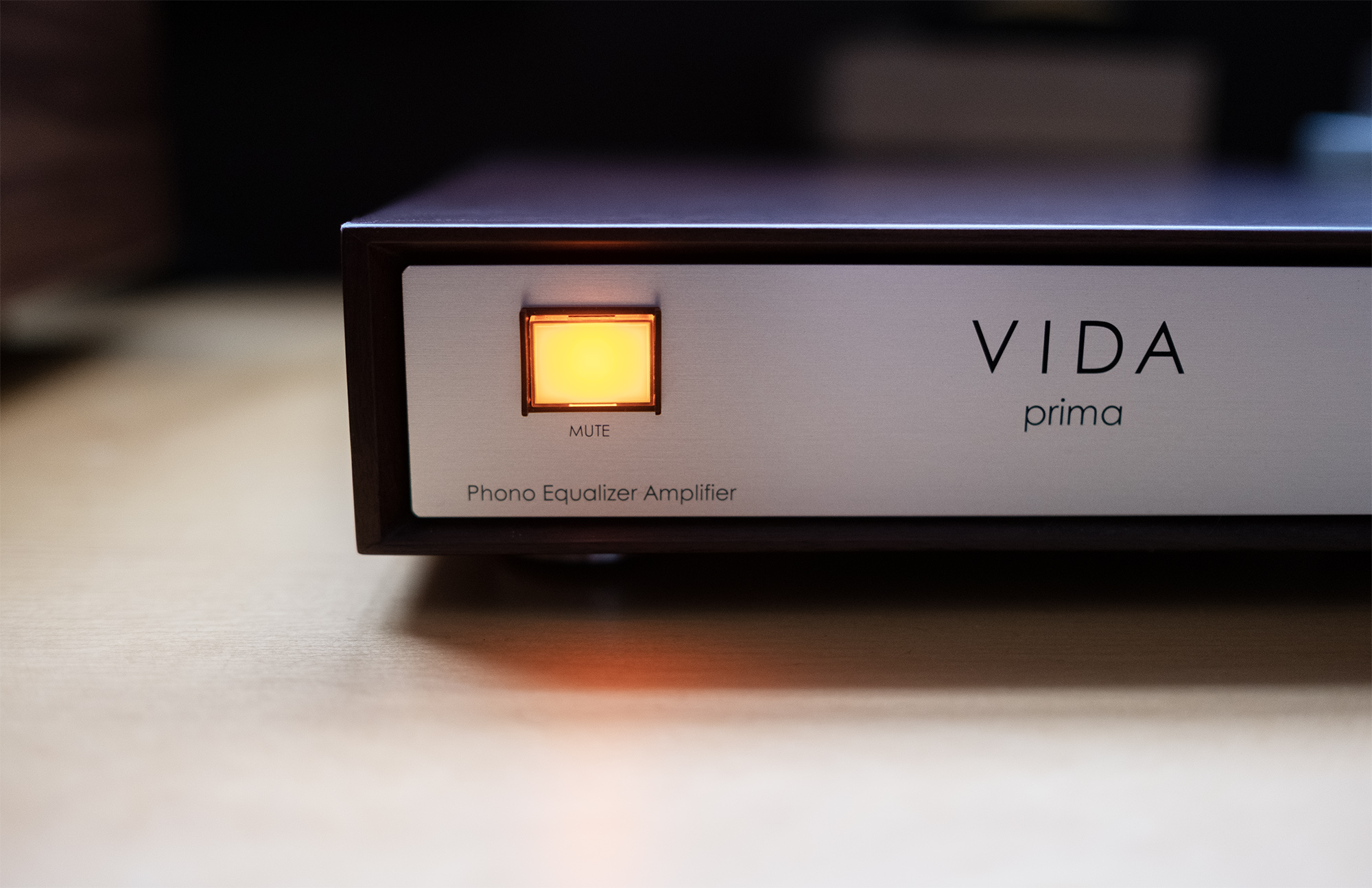
Shinobu Karaki is the President of Aurorasound Inc., which is based in Yokohama, Japan. Before founding Aurorasound in 2012, Karaki-san spent 28+ years at Texas Instruments as a Video Business Unit General Manager of the Digital Audio group (another digital to analog conversion story).
From the Aurorasound website:
The idea of making audio equipment like a craftsman who makes musical instruments is based on the philosophy that amplifiers should be works of art, not industrial products.
Amen to that! Karaki-san created his company to produce the products he wanted to hear, guided by measurements and ear.

The VIDA Prima is the entry phono stage in the Aurorasound line, which also includes a number of tube-based amplifiers, preamplifiers, a headphone amp, two more ambitious phono stages, and the very interesting looking EQ-100 Variable multi-curve phono equalizer (for mono records). The Aurorasound products share one common reaction according to my eyes—yum—at least from the photos.
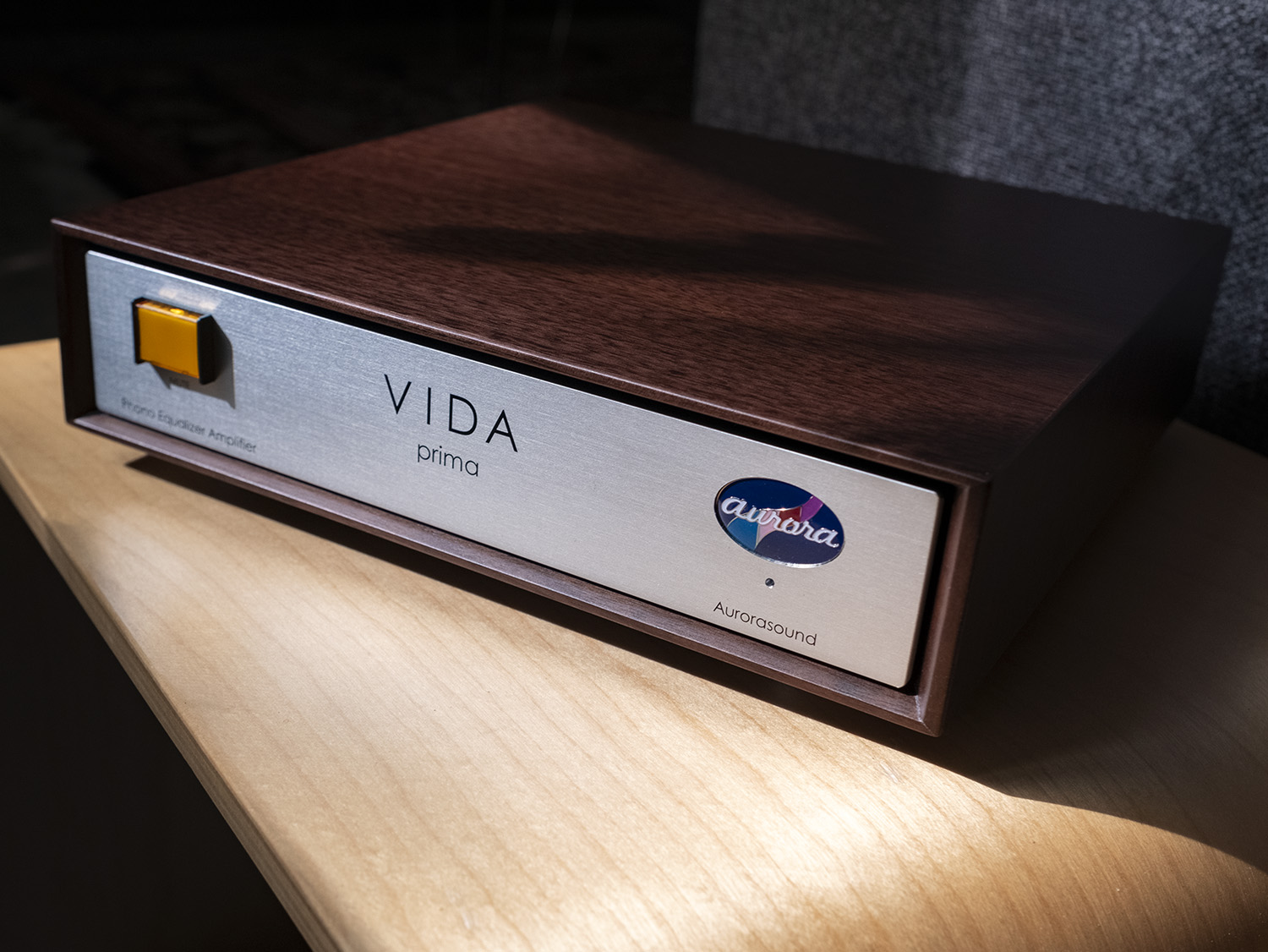
Happily, the Aurorasound VIDA Prima is even yummier in person. Modest in size (9.9 x 9.7 x 2.7 inches) and weighing a mere 5lbs., the VIDA’s wood wrapped chassis and aluminum front and back panels make for an elegant, understated appearance. The VIDA Prima looks like care went into its design, and its a pleasure to hold, behold, and use.
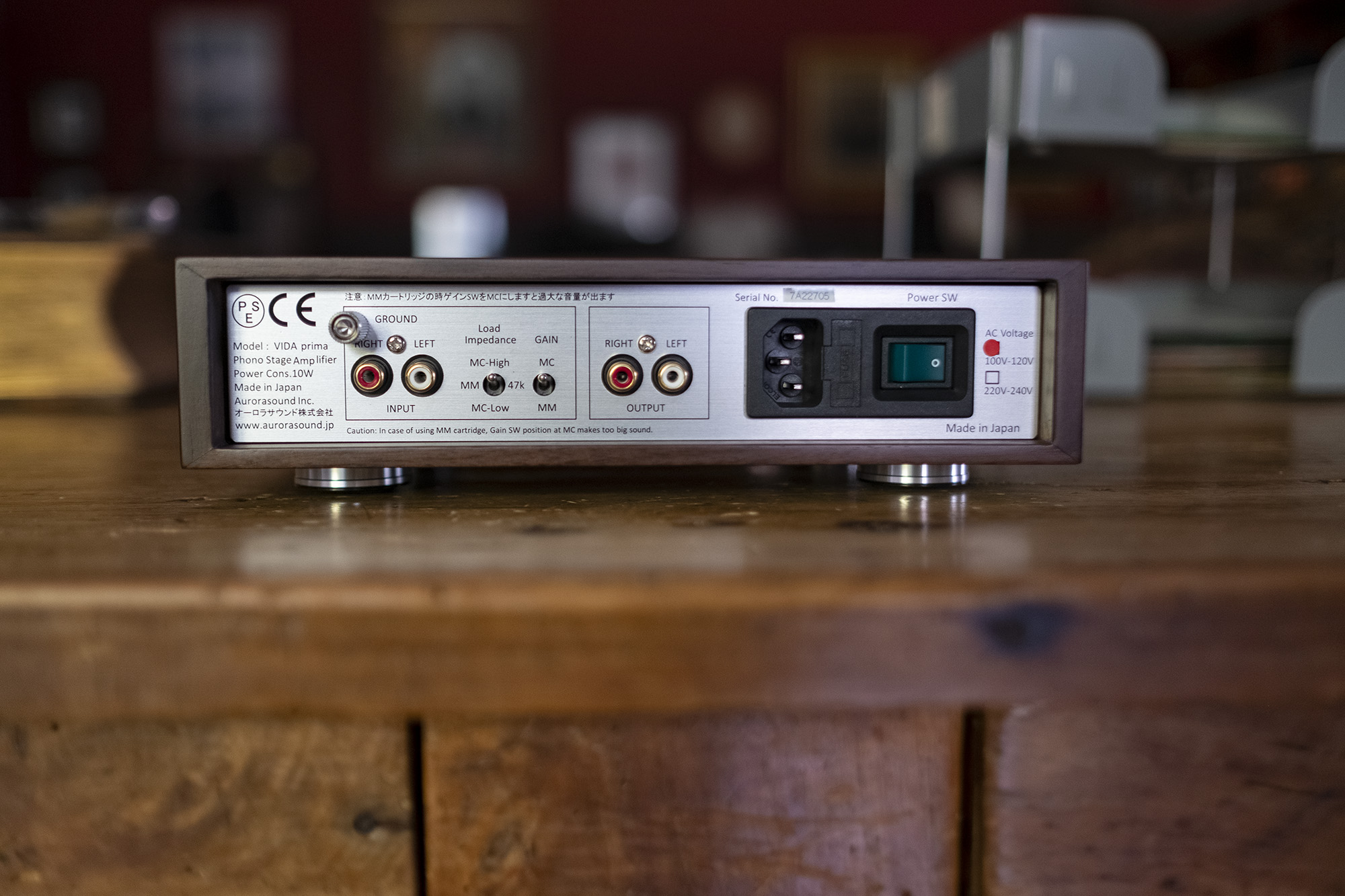
A pair of toggle switches around back offer Load Impedance and Gain setting options, accommodating Moving Magnet (MM) and some Moving Coil (MC) cartridges (MC High (10-100Ohm), MC Low (0.6-10Ohm). Equalizing is done according to RIAA standards, combining NF-type [negative feedback] and CR-type [capacitor/resistor] in one RIAA compensation circuit, while amplification is performed by Linear Technology and Texas Instruments regulators/op-amps. Other high quality parts abound including WIMA film capacitors, Japanese made precision metal film resistors, and a toroidal transformer that employs a Schottky barrier diode, Fine-Met beads, and audio grade capacitors. RCA inputs and outputs, a ground terminal, and an IEC inlet complete the backside’s picture.
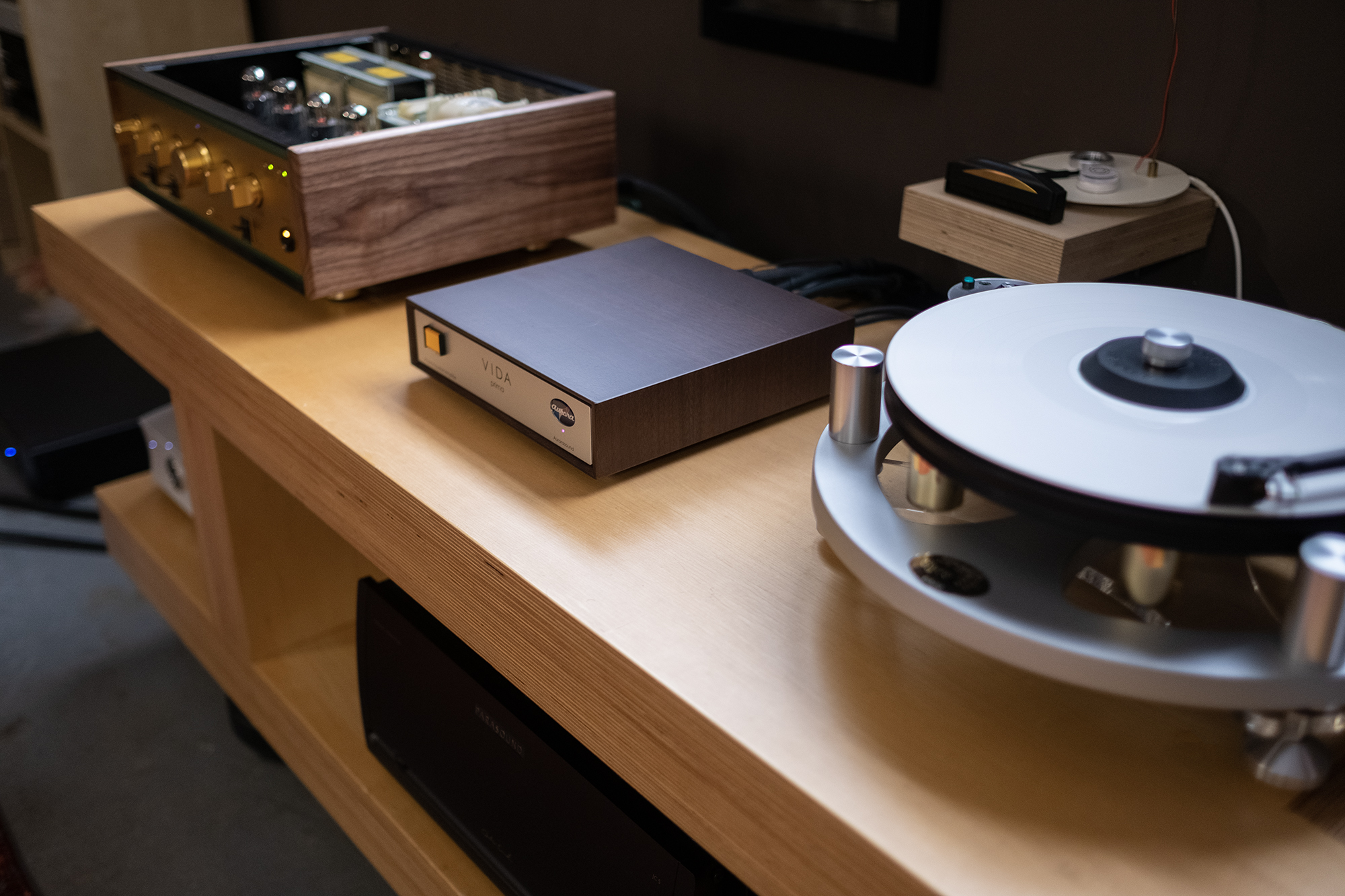
The VIDA Prima is roughly 3.5 times the price of the recently reviewed MoFi StudioPhono (review), which is more than 2 times the price of the Schiit Mani 2 (review). Some audiophiles ask questions like, “Is it really 3.5 times better?” to which I’ll answer—if you think so—since the answer is purely personal. Some audiophiles like to think their purely personal thoughts are somehow more universal, as if they should be enforced by some Standards Committee that would make buying what you want illegal. Or so it seems (see Diminishing Returns: HiFi’s Happy Secret).

The VIDA Prima sat in with *mostly* the same system used in the Schiit and MoFi reviews, and included the Michell Gyro SE turntable with the Michell T8 tonearm [footnote 1] mounted with an Ortofon 2M Black MM cartridge, Leben CS600 integrated amp, and the DeVore Fidelity O/96 speakers. All cabling were from AudioQuest.

Beginning with Anna St. Louis’ If Only There Was a River, which we listened to in the MoFi review, revealed that the VIDA Prima is even more revealing than the MoFi. The VIDA Prima also has a sweetness about its sound, where upper registers feel ripe, rich and full without any thinness or harshness, making this less than stellar recording easier on the ears and more inviting as compared to the MoFi’s comparably more strident sound. This is where I’m going to leave off with comparisons to the StudioPhono seeing as the VIDA Prima is in another price class and any notion of diminishing returns has yet to kick in. What I heard with the VIDA Prima was all increased returns, bringing a more fully realized Anna St. Louis into the Barn, occupying a larger and airier soundscape.
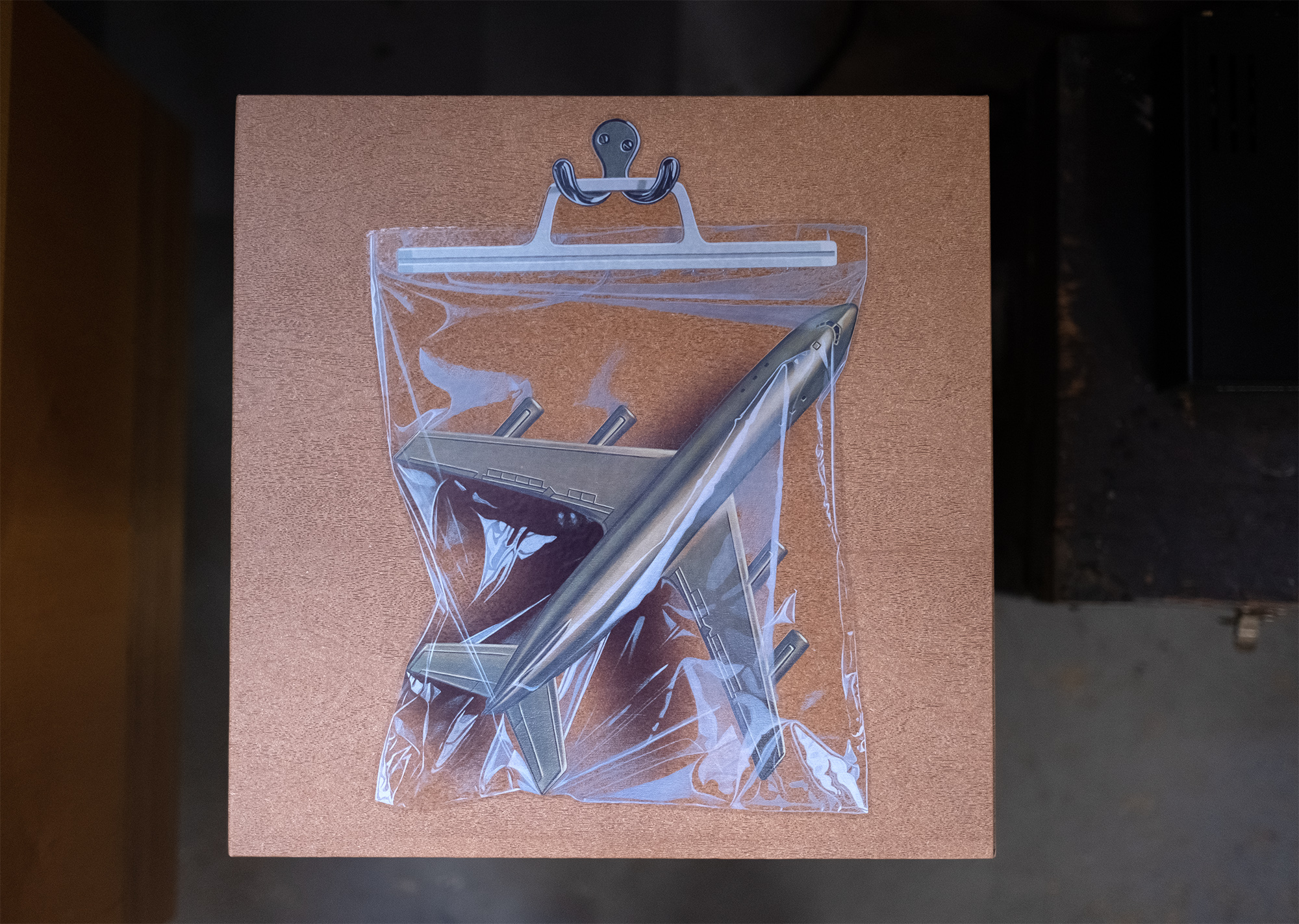
Black Country, New Road’s Ants From Up There is a splashy juggernaut of a record, with the 7-piece band hitting their stride just in time for lead singer and guitarist Isaac Wood to announce his departure from the group (sigh). This is big, bold, jarring music, with jagged edges and more starts and stops than a rush hour drive down 6th Ave. With the VIDA Prima feeding the Leben CS600X, listening through Ants From Up There was a wild joy ride, sounding rich, fit, and full. I will also share that near the end of Side A, the thought occurred to me that this kind of sound from a record is where analog starts to walk away from digital. Just how and why that’s the case is like trying to describe a better beautiful sunset, but to my mind it has something to do with perceived depth of sound, as if analog can better reproduce music beyond the skin, so to speak, making instruments and singers feel as if they have depth, dimension, and complexity that transcends surface, something some digital can seem to skim over. And there’s the elusive concept of time, which analog replay seems to understand better than digital…
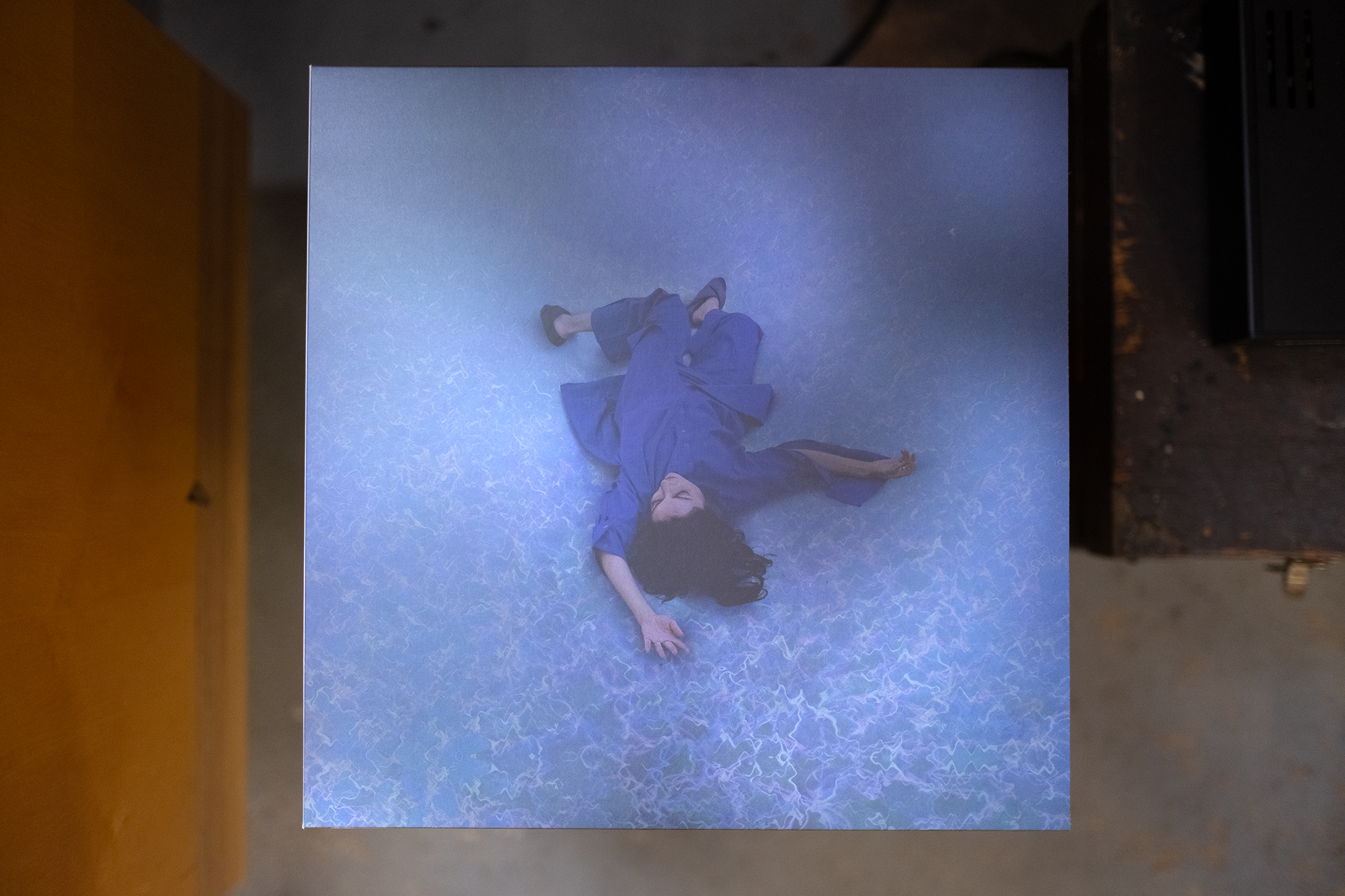
Lucrecia Dalt’s ¡Ay! is the gift that keeps on giving and it remains a favorite recent record, sitting at the tippy top of my list at the moment. Opener “No tiempo” slowly unfolds on cuckoo clock time, sounding like a mechanical bird falling apart or coming together in a jungleland of tropical delights. All manner of sounds, acoustic and manufactured, call out from a vast sound image, creating a strange and captivating place to explore. The VIDA Prima grabbed hold of every ounce of delicacy and delight, while offering a tight-gripped and nicely voiced way with acoustic double bass that grounds these exotic sounds. Dalt’s vocals are the perfect centering force, itself all mysterious yet alluring. The VIDA Prima’s presentation did this fine record full justice, from micro tweet to macro bloom with a mixture of sweet resolution and propulsive drive. Seductive.

Madness is nothing to sneeze at. Ghédalia Tazartès debut album, Diasporas originally released in 1979, is a journey to the far side of rational music making, replete with chants, tape loops, poetry (Stéphane Mallarmé), and repetition. I bought the 2020 repress from Dias Records on white vinyl and sitting through the full course of Diasporas feels like you’ve digested a great big surrealist cake, nearly overfull with splices of trimmed stream of consciousness Ladino. For all of its processed-ness, Diasporas is completely engrossing, and the VIDA Prima did fine work pulling out all the nooks, crannies, and creeks that propel Tazartès along his twisted path. The VIDA Prima once again proved to offer a wonderfully airy sound field for this music to unfold within, coupled with plenty of detail and sweet Aurorasound sound making the listening experience a treasure hunt in some strange twisted world of Tazartès’ waking dreams.
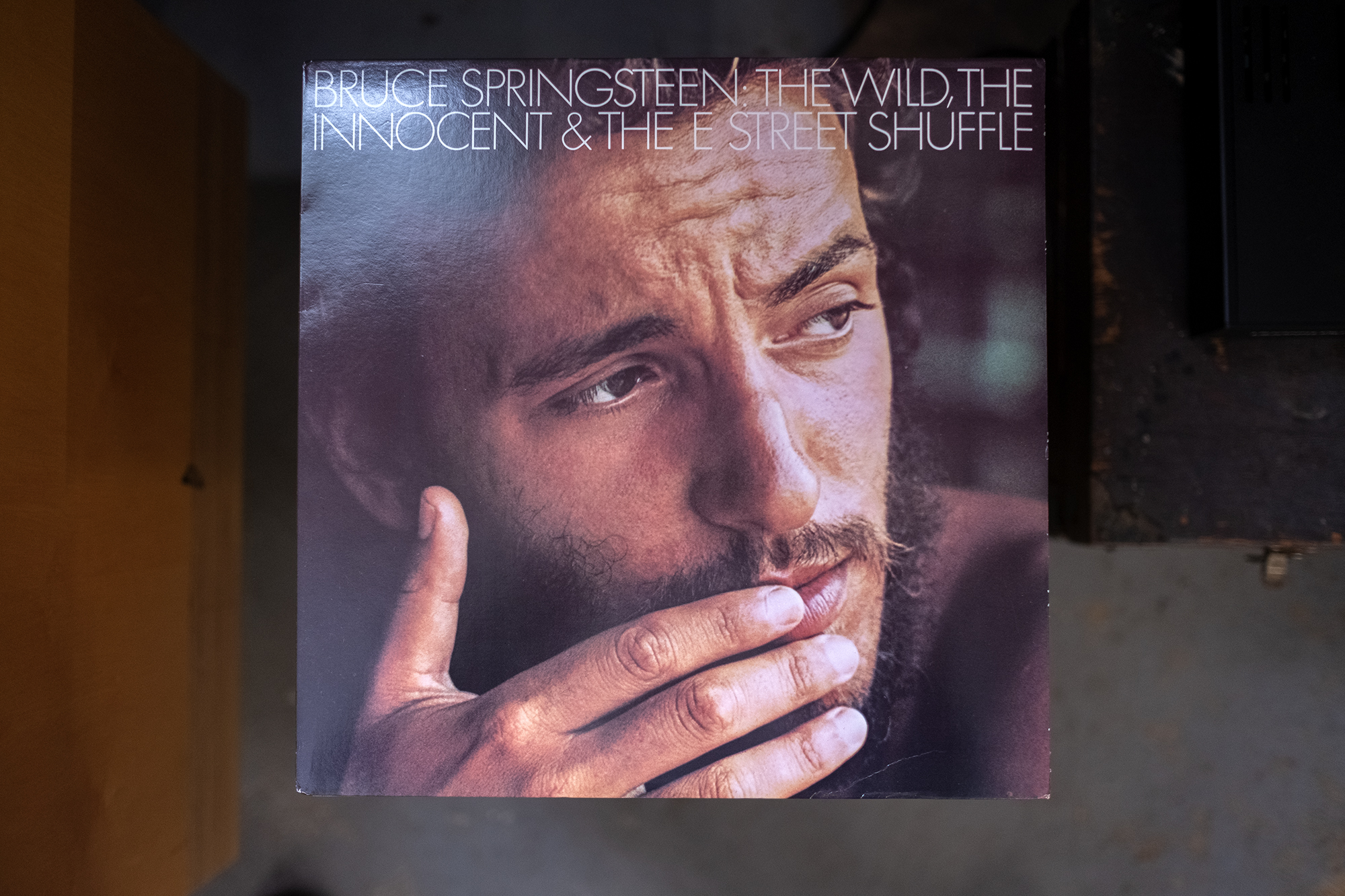
I’m always up for a trip down the shore (pronounced shuwaa), especially after bouncing around Diasporas, and what better way to get there than Bruce Springsteen’s sophomore release, The Wild, the Innocent & the E Street Shuffle. The carnivalesque atmosphere of the 1970’s Jersey shuwaa had its own kind of madness and Springsteen gives us the walking tour on “Wild Billy’s Circus Story” with tuba providing the jaunty marching orders.
Oh, and a press roll drummer go, ballerina to-and-fro
Cartwheelin’ up on that tightrope
With a cannon blast, lightnin’ flash, movin’ fast through the tent, Mars-bent
He’s gonna miss his fall, oh, God save the human cannonball
The VIDA Prima in this system brought this wonderland to life in Barn, with acoustic guitar strums glistening in the air and accordion, mandolin, horns, and more providing the local color with their unique full voices adding layers of depth and resonance backing these songs that brought me back to those strange, lonely, hot hopeful days and nights baking in the sun and walking the boards.
I listened to lots of records through the VIDA Prima and as the review period was coming to an end I made sure to hit a bunch of highlights for purely selfish reasons, namely pleasure. Paired with the Michell/Ortofon/Leben/DeVore system, the VIDA Prima lit up the Barn with sounds as sweet as honey all rich, detailed and—of greatest importance—well balanced that puts all of one’s attention front and center on the performance unfolding right there in front of you. From small and intimate to large and boisterous, the VIDA Prima did music proud.

Every piece of hifi gear performs its own kind of balancing act. Price, performance, design, and look & feel all play an important part in any purchase decision I make and the Aurorasound VIDA Prima Phono Stage hit that balancing act on the head. I more than enjoyed my time with the VIDA Prima for its cool understated looks and finely balanced way with all of the music that came its way.
1. My best laid plans to keep things consistent throughout the Phono Stage Survey were foiled when I had to replace the TecnoArm 2 due to a wiring problem. While I don’t know the exact cause of the problem, I’m going to assume it was my fault. Michell, through their US Distributor, kindly offered to replace the TecnoArm 2 with their new, and improved, T8 Tonearm (details forthcoming). Luckily, the T8 arrived in time for me to do some listening with the Schiit Mani 2 and MoFi StudioPhono, so my end of Survey conclusions will be based on the T8.
Aurorasound VIDA Prima Phono Preamp
Price: $1290
Company Website: Aurorasound
US Distributor Website: highend-electronics
Specifications
| Input: | One pair RCA unbalanced with ground Cartridge load impedance select switch: MM (47kOhm), MC High (10-100Ohm), MC Low (0.6-10Ohm) |
| Output: | Line Level, unbalanced RCA |
| Output Impedance: | 47Ohm |
| RIAA Deviation: | 20Hz – 20kHz +/- 1dB |
| THD+N: | MC 0.01%, MM 0.009% |
| Input Noise: | MC -134dBV, MM -134dBV |
| Gain: | MC-High/64dB, MC-Low/40dB, MM/40dB |
| Dimension (WxDxH): | 250mm x 246mm x 69mm 2.3kg (9.9 x 9.7 x 2.7 inches, 5lbs.) |

